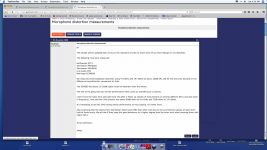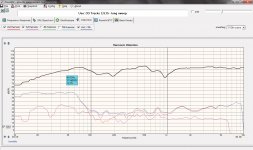JBL Eon 15 G2 Recone Kit 2 Ohm
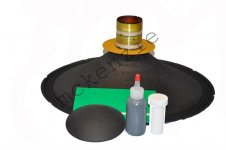
I have not investigated JBL Eon magnet assy, maybe some food for thought ?.
Dan.

I have not investigated JBL Eon magnet assy, maybe some food for thought ?.
Dan.
Richard, I must have missed what distortion your inexpensive mike has at lower, but usable operating levels. What do you expect at 80spl? Or any other near amplitude?
Very interesting thanks! The Sennheiser might have a symmetrical capsule but they use an FM detector which I remember as being very hard to tune up to stay at -80dB consistently. IIRC the Foster-Seely and ratio detectors both have dominant seconds when tuned off center a little.
JBL Eon 15 G2 Recone Kit 2 Ohm
View attachment 730303
I have not investigated JBL Eon magnet assy, maybe some food for thought ?.
Dan.
Oh. Yes, recone/repair kits. That would make it a lot easier to modify and change VC windings etc.
THx - Richard
Richard, I must have missed what distortion your inexpensive mike has at lower, but usable operating levels. What do you expect at 80spl? Or any other near amplitude?
I will put some of them up - only electrets --- the typical THD ranges from -60 to -80dB on these three.... Plenty good enough for dynamic speaker driver measurements. I have others also -- some with very flat FR.
I ordered OM1 Line Audio for its low THD and high SPL: 133db at 0.5% THD.
Over-all, these mic types are fine. And many come with correction files for FR.
They are a suitable choice for DIY tests and are low cost, too.
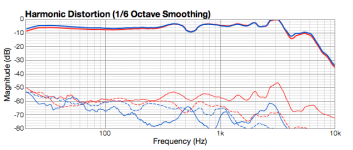
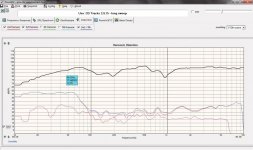
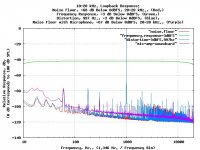
THx-RNMarsh
Attachments
Last edited:
Yes. That company and others (one was referenced here) can supply all the bits to build drivers from scratch, and economically.Oh. Yes, recone/repair kits. That would make it a lot easier to modify and change VC windings etc.
THx - Richard
Winding bespoke VC assy's then coupled (glued) to off the shelf cones and surrounds and baskets looks like ripe for experiment.
I expect there are DIY speaker driver forums that are catered for by the above kinds of suppliers....there might be some good experience there.
Dan.
Well, thanks to Demian, I now have a way to use my 1/2" capsules with a B&K preamp to better test a few speakers of my own. I want to compare the LS3-5A to the Sequerra Met7. One is optimized for frequency response, one for TIME response. Both are excellent small speakers. What is more important? Time or flat frequency resp? I hope to find out.
You know the answer ;-)Well, thanks to Demian, I now have a way to use my 1/2" capsules with a B&K preamp to better test a few speakers of my own. I want to compare the LS3-5A to the Sequerra Met7. One is optimized for frequency response, one for TIME response. Both are excellent small speakers. What is more important? Time or flat frequency resp? I hope to find out.
Frequency resp is easy to be linearized.
Well, thanks to Demian, I now have a way to use my 1/2" capsules with a B&K preamp to better test a few speakers of my own. I want to compare the LS3-5A to the Sequerra Met7. One is optimized for frequency response, one for TIME response. Both are excellent small speakers. What is more important? Time or flat frequency resp? I hope to find out.
I prefer to have both.
-Richard
Of course, it is best to have both, but it usually isn't practical. In fact, if you include low distortion as well, than you add another variable that makes speakers almost impossible to get right. Yet, are all three completely necessary? It might depend on the listening room size, listening level, and what kind of music you prefer to listen to.
Horns, properly done, can be low distortion, both regular harmonic and IM, and Doppler distortion. Almost all direct radiators will have more distortion, unless you use dozens of direct radiators to reduce each driver's contribution.
Electrostatic and Magneplanar speakers can have low phase or TIME distortion, but never will get very loud, compared to horns or large direct radiators, and sometimes can have terrible frequency response, sometimes far worse than they actually sound like, and as well at very high and low frequencies.
It is very difficult to get multiple horns or horn and direct radiator hybrids to have great TIME response. Yes, you can match the drivers up acoustically, but the added characteristics of the both the direct radiators (usually used for lower frequencies) and horns make putting them together almost impossible with any sort of normal speaker xover. Etc, etc. Now again, what is the most important?
Horns, properly done, can be low distortion, both regular harmonic and IM, and Doppler distortion. Almost all direct radiators will have more distortion, unless you use dozens of direct radiators to reduce each driver's contribution.
Electrostatic and Magneplanar speakers can have low phase or TIME distortion, but never will get very loud, compared to horns or large direct radiators, and sometimes can have terrible frequency response, sometimes far worse than they actually sound like, and as well at very high and low frequencies.
It is very difficult to get multiple horns or horn and direct radiator hybrids to have great TIME response. Yes, you can match the drivers up acoustically, but the added characteristics of the both the direct radiators (usually used for lower frequencies) and horns make putting them together almost impossible with any sort of normal speaker xover. Etc, etc. Now again, what is the most important?
Of course, it is best to have both, but it usually isn't practical. In fact, if you include low distortion as well, than you add another variable that makes speakers almost impossible to get right. Yet, are all three completely necessary?
Today... you can get all three. Lot of new speakers now can do it all.
The JBL M2 is one which covers all the bases very well. But, also several 2 way near-field 'monitor' speakers can do it. Dont forget DSP is an available tool also.
Other tools like DEQX are also available. Home - DEQX
THx-RNMarsh
Last edited:
... OM1 Line Audio for its low THD and high SPL: 133db at 0.5% THD...
Thats what I use for recordings but also for measurements (it's a .zip)
//
Attachments
As Richard said, with active filters using DSPs, we can do whatever we want: Slope and Q of the filters, response curve correction with multiple EQ, time delays. etc.It is very difficult to get multiple horns or horn and direct radiator hybrids to have great TIME response.
DEQX or Behringer.
Last edited:
If you are happy with DSP correction, then I am all for you. I know that Richard depends on digital correction, however I don't. I really don't like digital that well. Perhaps someday. Yet, I don't think that most people have a good idea about their individual speaker system and its tradeoffs. That is what I prefer to talk about.
John, I thing I understand the reason why you "don't like digital that well". ;-)If you are happy with DSP correction, then I am all for you. I know that Richard depends on digital correction, however I don't. I really don't like digital that well. Perhaps someday.
A feeling that something is lost or missing in the signal.
But, if, one day, you have the opportunity to compare (blind if possible) an original analog master to its vinyl copy, an analog tape copy and a (good) digital copy, you will definitively change your mind ;-)
...And begin to dedicate all your attention to the analog part that follows the DACs.
Last edited:
Of course. The only real problem is the Woman Acceptance Factor, if you try to time align low medium horns with bass speakers in an enclosureUREI was making time alined horn speaker with analog filter in 70's, and JBL did in 80's, so it is not impossible, but I have to agree that those are a few exceptions.
that you draw for domestic living rooms ;-)
Last edited:
Of course. The only real problem is the Woman Acceptance Factor, if you try to time align low medium horns with bass speakers in an enclosure
that you draw for domestic living rooms ;-)
Avantgarde Acoustic have nice horn speakes with big low-medium horns that as I learned do have a reasonable "Woman Acceptance Factor". They come at a price though.
If you are happy with DSP correction, then I am all for you. I know that Richard depends on digital correction, however I don't. I really don't like digital that well. Perhaps someday. Yet, I don't think that most people have a good idea about their individual speaker system and its trade offs. That is what I prefer to talk about.
I also prefer HD wave file downloads rather than turn table/arm/cartridges/LP/RIAA for greater over-all accuracy.
The simpler corrections like for FR and cross-overs can be easier to do without DSP. But when you want to do time and freq and also group delay EQ --- its a lot harder and the complexity might affect many other things we hear if you try to do all in analog format.
There are as many DSP hard/soft as there are analog designs. They are not all the same. Algo, filtering, jitter etc differ. Some are better than the others. But, all-in-all, the very best DSP result is better because More is improved and corrected. Not just optimized for one or maybe two issues corrected.
THx-RNMarsh
Last edited:
T, I am not going to argue with you or Richard about the advantages of digital. Also, IF I had to buy a quality loudspeaker today, I would probably buy a JBL similar to Richard's, but I am a 'victim' of being given a speaker too expensive to refuse, yet not always as happy with it, as I might wish to be. My suspicion is the TIME response of the expensive speaker. PMA disputes me on this, so it is him that I am disputing, not you or Richard.
Now, I personally think that complementary jfets (preferably Toshiba) are the ONLY way to go in designing amps, preamps, D-A analog electronics, etc, so should we discuss ONLY designs with these devices dominant? '-)
Now, I personally think that complementary jfets (preferably Toshiba) are the ONLY way to go in designing amps, preamps, D-A analog electronics, etc, so should we discuss ONLY designs with these devices dominant? '-)
- Status
- Not open for further replies.
- Home
- Member Areas
- The Lounge
- John Curl's Blowtorch preamplifier part III
